Reactions of Group 2 Elements (A-Level Chemistry)
Reactions with Oxygen
- Group 2 elements burn in oxygen to form a metal oxide. The reaction between a Group 2 element and oxygen is a redox as Group 2 elements are oxidised from an oxidation state of 0 to +2 and oxygen is reduced from a 0 state to -2. Group 2 metal oxides are all white solids.

- Different Group 2 elements will produced different colored flames. This characteristically colored flame is caused by the presence of 2+ ions and hence can be used as a test for the presence of Group 2 metal ions.
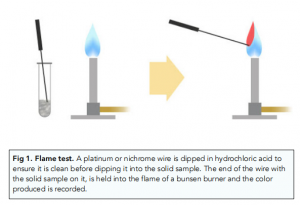
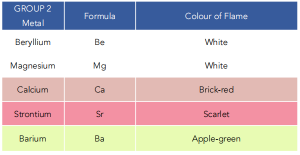
Group 2 Reactions with Water
- Group 2 elements react readily with cold water to form a metal hydroxide and hydrogen. The reactions of group 2 metals with water is a redox as Group 2 elements are oxidised from an oxidation state of 0 to +2. Hydrogen is reduced from a +1 state to 0. The group 2 elements form +2 ions with then react with water.

- The rate of reactivity with water of the elements increases as you move down the group. Beryllium does not react at all, magnesium reacts very slowly whereas barium reacts rapidly.
- Group 2 metals react vigorously with steam to give a metal oxide and hydrogen. Note the difference in products formed depending on how hot the water is.

- Group 2 metal oxides react vigorously with water to give a metal hydroxide. The reaction is so exothermic that some of the water will evaporate off. Unlike the reactions with Group 2 metals, no hydrogen is given off.
- Group 2 hydroxides form weakly alkaline solutions. The metal hydroxide dissolves in water to give an excess of OH- ions, which increase the pH of the solution.
Reactions with Acids
- Group 2 elements react readily with dilute acids to form a salt and hydrogen. The reaction between a Group 2 element and oxygen is a redox as Group 2 elements are oxidised from an oxidation state of 0 to +2 and hydrogen is reduced from a +1 state to 0. Reactivity increases down the group.

- Group 2 metal oxides, hydroxides and carbonates also react with dilute acids to form a salt. The group 2 elements reactions with metal oxides or hydroxides will also give water and reactions with metal carbonates will also give water and carbon dioxide.Let M represent any Group 2 element:E.g. MO (s) + acid (aq) —> salt (aq) + H2O (l)E.g. M(OH)2 (s) + acid (aq) —> salt (aq) + 2H2O (l)
E.g. MCO3 (s) + acid (aq) —> salt (aq) + CO2 (g) + H2O (l)
Polarising Power Trends of Group 2 Ions
Ion polarisation
Ion polarisation is when a cation distorts the electron cloud of a neighboring anion by attracting the delocalised electrons towards it.
How strongly a cation can polarise an anion, depends on the charge density of the cation.
This in turn depends on its size and charge: the smaller the ionic radius of the cation and the greater its charge, the greater its charge density and hence its polarising power.
As we go down Group 2, the polarising power of the metal cations decreases.
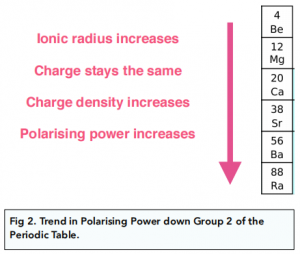
Thermal Decomposition of Carbonates and Nitrates
Carbonates of Group 2 elements decompose upon heating. They break down to form the metal oxide and carbon dioxide.
Let M represent any Group 2 element:
E.g. MCO3 (s) —> MO2 (s) + CO2 (g)
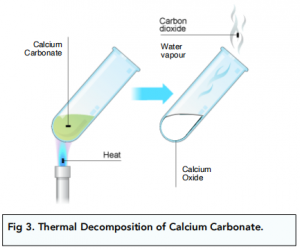
- Thermal stability of Group 2 carbonates increases as we go down the group. As we go down the group, the polarising power of Drop 2 metal cations decreases. The greater the polarising power of the cation, the more it will polarise the carbonate ion, weakening the covalent bonds between the carbon and oxygen atoms in its structure so that they are more likely to break upon heating to form carbon dioxide and the oxide.
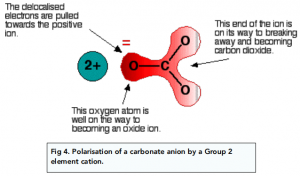
- Nitrates of Group 2 elements decompose upon heating. They break down to form the metal oxide, nitrogen (IV) oxide and oxygen gas.Let M represent any Group 2 element:E.g. 2M(NO3)2 (s) —> 2MO2 (s) + 4NO2 (g) + O2 (g)
- Thermal stability of Group 2 nitrates increases as we go down the group. Just as with carbonates, the temperature at which nitrates decompose increase as we go down the group due to changes in ion polarisation.
Solubility Trends of Group 2 Elements
Solubility Trend of Hydroxides
- As you move down Group 2, the solubility of compounds containing singly charged negative ions increases. If a Group 2 compound consists of negative ions that have a single charge such as OH-, the solubility of these compounds in water increases as you move down the group.
- As you move down Group 2, solutions of metal hydroxides become more alkaline. As we saw before metal hydroxides dissociate in solution to give an excess of OH- ions. The further down the group the metal, the more soluble its metal hydroxide and hence the more OH- it will dissociate into, increasing the pH of the solution.
- Magnesium hydroxide is known as being sparingly soluble in water. Magnesium hydroxide is not very soluble in water (will form a precipitate) whereas barium hydroxide is very soluble.
Solubility Trend of Sulfates
- As you move down Group 2, the solubility of compounds containing doubly charged negative ions decreases. If a Group 2 compound consists of negative ions that have a double charge such as SO42-, the solubility of these compounds in water decreases as you move down the group.
Test for Sulfate Ions
- Barium sulfate (BaSO4) is insoluble in water. Barium sulphate does not dissolve in water and instead forms a white precipitate when mixed with water.
- Acidified barium chloride can be used to test for sulphate ions. A white precipitate of barium sulphate will form if acidified barium chloride is added to a solution containing sulphate ions. This is a test for the presence of sulphate ions. The barium chloride is acidified using hydrochloric acid to remove excess sulphites or carbonates in the solution which could also produce a white precipitate and mask the results.

Group 2 elements are a set of chemical elements that belong to the second column of the periodic table. They are also known as alkaline earth elements.
Group 2 elements have moderate reactivity, they are less reactive than Group 1 elements but more reactive than Group 3 elements.
Group 2 elements primarily undergo displacement reactions, where they replace another element in a compound. They also form compounds by reacting with non-metals such as chlorine, bromine, and oxygen.
The reactivity of Group 2 elements increases from top to bottom in the group. This means that the lower elements in the group are more reactive than the higher elements.
Group 2 elements are less reactive than Group 1 elements, which are known as the alkali metals. Group 1 elements are highly reactive and easily give up electrons, while Group 2 elements have a lower tendency to do so.
The most reactive element in Group 2 is beryllium (Be), while the least reactive is barium (Ba).
Group 2 elements react with water to form an alkaline solution. The reaction becomes more vigorous as you go down the group, with the most reactive elements, like beryllium, reacting very slowly, while the least reactive elements, like barium, reacting very vigorously.






Still got a question? Leave a comment
Leave a comment